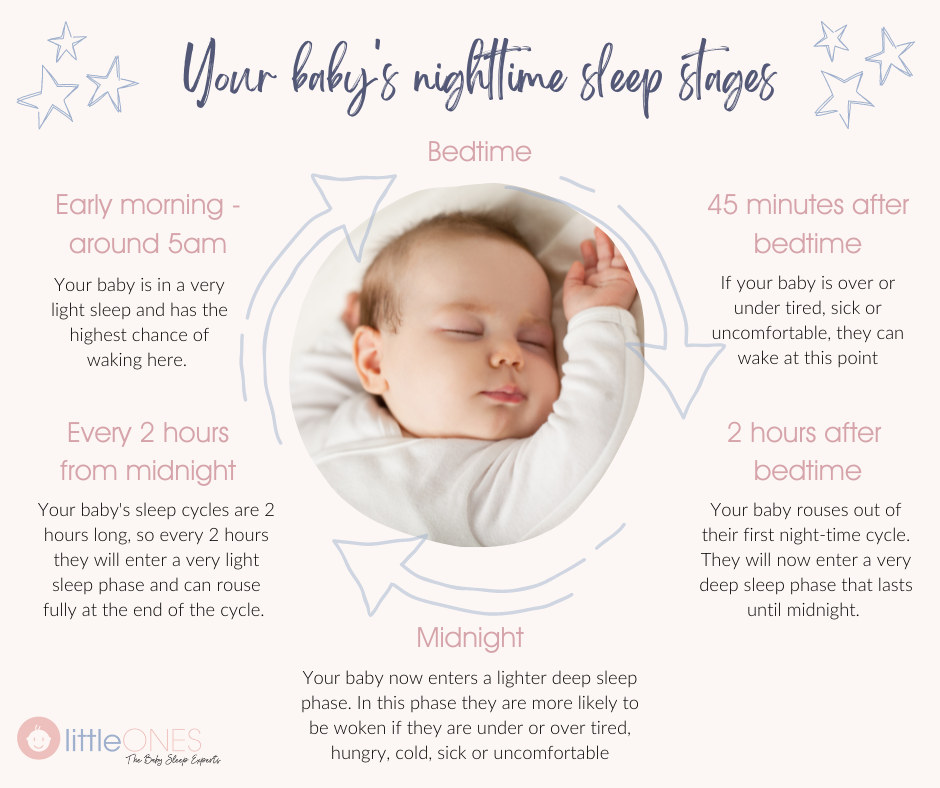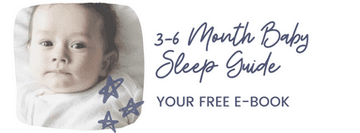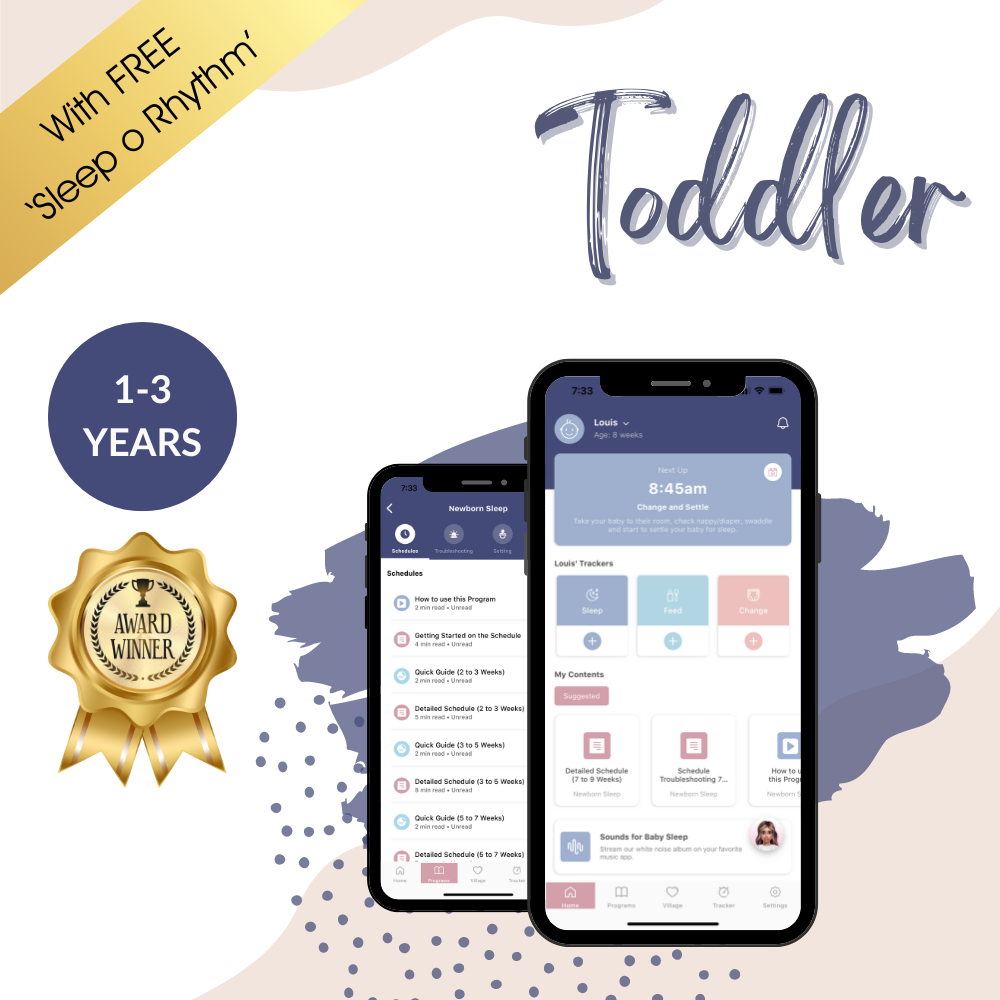
3 Month Old Sleep Schedule: Naps, Nights & Wake Windows (With Chart)


Between 3-6 months is probably the trickiest period of baby sleep. During these few months, your baby's sleep will become a lot more like ours as adults, with more distinct periods of light and deep sleep and more neurologically differentiated sleep cycles. It is during this time that a baby's sleep habits are really becoming important too. Let's have a look at what is happening for your wee one at this time...
In this article:
- 3 month sleep schedule
- When do baby sleep cycles begin to change?
- How daytime sleep cycles work
- Nighttime sleep stages
- How much sleep does a 3 month old baby need?
- Oversleeping and Catnapping
- Night feeds
- The importance of routine
Feeling confused about your baby's sleep needs?
Let our sleep experts help you every step of the way. Together we can solve your little one's sleep challenges
Get our Sleep Programs
3 month sleep schedule
By 3 months of age, most babies will be sleeping around 15.5 hours over a 24 hour period. At 3 months old, babies generally have 3.5 hours of daytime sleep, spread across 3 naps, with around 12 hours overnight sleep. They will need between 2 hours of awake time between each nap and before bedtime.
The chart below shows what your 3 month old sleep schedule might look like.
NOTE: When creating a nap schedule for your little one, always allow for 12 hours sleep overnight (which will include feeds).
- Morning wake (ideally 7am)
- Wake window of 2 hours
- Short morning nap
- Wake window of 2 hours
- Long lunchtime sleep (aim for 2 hours)
- Wake window of 2 hours 15 minutes
- Short afternoon nap
- Wake window of 2 hours
- Bedtime (ideally 7pm)
When do baby sleep cycles begin to change?
Baby sleep is an ever-changing phenomenon. In the first few months of a baby’s life, their sleep is quite unorganised and they are driven by a biological urge to sleep. Some babies will simply fall asleep on their own when they are tired, others need more hands-on settling to help them drift off.
During this time:
- A baby's daytime sleep cycles are not as pronounced as they will later become
- Babies this age do not consciously rely on a series of sleep cues or behaviours in order to fall asleep.
The biggest change in your baby’s sleep cycle happens at around or close to 4 months old and this is commonly known as the 4 month sleep regression. It is possibly the biggest change in your baby’s sleep that will ever happen! At 3 months old, your little one might start exhibiting signs of this sleep change.
Here are some of the changes you can expect to see:
- Your baby may start to wake fully between each sleep cycle rather than drift between cycles automatically.
- If your baby is relying on a parent-led sleep association like rocking or feeding etc, they will now need you to replicate this EVERY time they wake between cycles (Every 35-45 minutes in the day and 1-2 hours overnight)
- Your baby might not be able to go back to sleep after that cycle if they can’t self-settle, therefore they will end up being overtired in the evening. This is known as catnapping (more on this later!).
Unfortunately, this sleep regression won't go away until your baby has learnt how to self-settle. This simply means your baby is able to fall asleep on their own when they’re ready to. Self-settling doesn’t just develop overnight, it is something new for babies and they need coaching, consistency and the chance to work on this new skill.
NOTE: Remember not all babies will reach these developmental stages at these exact ages, so if your baby is 3.5 months and starts waking every 1-2 hours overnight, it's safe to assume they've hit the 4 month regression.
How daytime sleep cycles work

- 0-10 minutes
Your baby starts to fall asleep and enters a light sleep stage. This is where they can easily be woken by wind, being put down if held, or a sudden noise.
- 10-20 minutes
Your baby starts to enter a deep sleep stage and will become unaware of their surroundings.
- 20-30 minutes:
Your baby is deeply asleep. Their breathing is deep and regulated and this is the most restorative part of their sleep cycle.
- 30-40 minutes:
Your little one starts to come out of their deep sleep stage and if they are over/undertired, they can wake fully at this point.
- 40-45 minutes
Sleep cycle finished. Your baby will either fully wake up or enter another sleep cycle, starting with a light sleep stage.
Stages of night time sleep
Babies sleep cycles are longer in the night than in the day and they are sleeping their deepest between bedtime and midnight. Take a look at this chart to see how a baby’s night-time sleep works:

- 45 minutes after bedtime
If your baby is over or under tired, sick or uncomfortable, they can wake at this point.
- 2 hours after bedtime
This is where your baby rouses out of their first night-time cycle. They will now enter a very deep sleep phase that lasts until midnight. In this phase they are less likely to wake unless they are sick or hungry.
- Midnight
Your baby’s deep sleep phase ends and they enter a lighter sleep phase. In this phase they are more likely to be woken if they are under or over tired, hungry, cold, sick or uncomfortable.
- Every 2 hours
Your baby’s sleep cycles are 60 to 90 minutes long, so roughly every 2 hours they will enter a very light sleep phase and can rouse fully at the end of the cycle. This is where some babies might need help going back to sleep if they can’t self-settle.
- 5 AM
Your baby is at their highest chance of waking here. If they can wake, it can be very hard to get them back to sleep, especially if they’ve slept well overnight up until this point.
The importance of naps
Sleep is as much a nutrient for babies as milk. It is just as important for their growth and development. In order to encourage good night sleep, babies need to have age-appropriate day time naps.
Babies need a delicate balance of day sleep vs night sleep. Too much OR too little day sleep will make them harder to settle and can also lead to night waking or early morning waking.
To find out more about the importance of napping for your little one check out our article here
How many naps are appropriate per day?
By 3 months your little one should have consolidated their sleep into three naps across the day - ideally a shorter nap in the morning, longer nap at lunchtime and a short, late afternoon nap.
We believe it is vital to establish and maintain a long restorative nap of approximately 2 hours across the middle of the day when there is a natural dip in their energy levels.
Our reason for aiming for this long consistent nap is that during restorative sleep, babies enter REM and this is where a whole lot of amazing stuff happens! For example, their appetite and emotions are regulated, stress and cortisol levels are reduced, new skills and memories are consolidated, their immune system is boosted and brain connections are made and strengthened.
Wake Windows
Now, napping is hugely important for your little ones development, but having the right amount of awake time is just as important, as too much awake time can lead to over tiredness, while too little awake time can lead to under tiredness. Both of which lead to poor napping and/or poor nighttime sleep. This can mean a grumpy baby and very frustrated parents!
By 3 months old your baby needs a lot more awake time than when they were a newborn. At this age, your baby is a lot more aware of the world and will love playing, laughing and visual stimulation.
So, if you're still trying to put your 3 month old to bed after an hour of being awake, you're most likely going to experience a lot of protesting from your wee one or you'll have to do a lot more rocking or feeding to get them to go to sleep in the first place!
At 3 months old babies need between 2 hours to 2 hours 15 minutes awake time between each nap and before bedtime in order to settle easily and sleep well.
Following the age-specific schedules in our Baby Sleep App helps to take the guesswork out of your baby's sleep needs and ensures they are getting the right balance of awake time and sleep throughout the day and night.
What if my baby needs more sleep?
Sleep is a nutrient for your baby. It sustains their physical, mental, emotional and social development, but can they have too much of a good thing?
The answer is yes! Too MUCH day sleep can lead to difficulties settling, a lot of night waking and early morning waking - simply because your baby needs more awake time.
Now, if your baby is having some longer naps during the day, but is still settling easily and sleeping well overnight - great! Enjoy the extra sleep while you can! If they are settling and sleeping well both day AND night, it means their balance of awake time and sleep is spot on.
Say goodbye to sleepless nights.
Join over 800,000 families worldwide who are enjoying excellent sleep with our Sleep Programs, created by experts in the field of pediatric sleep.
Get our Sleep Programs
BUT if your little one is becoming difficult to settle, or they have started to wake more overnight, it might be time to take a closer look at the awake time and sleep they are having during the day. And here comes the sometimes contentious part - you may need to wake your baby.
I know, shocking right? While it might seem counter-intuitive (or even downright mean!) to wake a sleeping baby, we do advise doing this if your baby is at risk of having had too many daytime sleep hours, or they are sleeping for too long in the morning nap, which will mean their lunch nap is consequently shorter, or if they're sleeping too late or long in the afternoon, which will have a negative impact on their bedtime settling and nighttime sleep. For more info see THIS article.
We like to say it is better for you to wake your baby in the day, rather than your baby wake you in the night!
What if my baby just wants to catnap all day?
While some babies would quite happily sleep the day away, catnapping is a much more common issue between 3-6 months old. Catnapping means your baby is only sleeping for one sleep cycle at a time (between 35-45 minutes), which can be caused by under or over tiredness or their reliance on a parent-led sleep association.
Is catnapping a problem?
Now we are by no means saying that catnapping is "bad" or a "problem" and it is in fact, a developmental portal all babies must pass through, peaking between 4-6 months. That said, we do know that prolonged catnapping can begin to impact a baby's night-time sleep due to a build-up of overtiredness throughout the day.
How do I deal with catnapping?
If your baby is catnapping, your best line of defence is to allow them to learn to self-settle at the start of naps. Even then, some babies will need help to resettle during a nap to get a longer stretch of sleep - this is completely normal and for some babies it can last quite a while! Resettling them here rather than getting them up from their nap helps teach them to sleep for longer.
It is in this tricky sleep stage that it is important to foster good sleep habits, so aiming to have your baby do at least one nap a day in their bed is a great way to head towards better sleep.
To read more about catnapping and what causes it, read our catnapping article here.
Night feeds - when can you stop them?
We can't tell you when to stop night feeds as it depends a lot on the age of your baby and their calorie intake during the day. We can tell you that it’s very normal for your baby to still be having 1-2 feeds at night until they’re well established on solids. And between 4-6 months, as babies gear up to start solids, it's quite common for them to wake for an additional feed.
It’s not always going to be hunger waking your baby overnight, so we suggest ruling out some other factors first before tackling any night weaning:
- Too much or too little day sleep
The first thing you'll want to rule out is if your baby’s night waking is being caused by them having had too much or too little day sleep or if their naps aren’t quite at the right times during the day to promote good sleep overnight. The age-specific sleep and feed schedules in our Baby Sleep App can help with this.
- Sleep environment
It's also worth looking at your baby's sleep environment. We recommend sleeping your baby in a dark room to promote the release of the sleep hormone, melatonin and you can also try using white noise to help your baby sleep more deeply and link their cycles together. A swaddle (for babies who aren't rolling yet) or baby sleeping bag will also help to regulate your baby's temperature overnight.
- Daytime calories
Ideally you want to make sure that your little one is getting enough calories in their waking hours to sustain them overnight, so that they are less likely to wake hungry.
Once you’ve ruled out all of these factors, you can look at when your baby is waking for a feed in the night. If they are waking and feeding 2 hourly and they are close to 4 months old, this is usually a settling issue, rather than genuine hunger - especially if they can go for longer than 2 hours between feeds in the day.
The importance of routine
Routine is a tricky word because it can imply a very rigid regimental pattern to your day and certainly for very young babies, we know that's not always entirely possible and it's not something we would even really advise.
But, in saying that, an element of structure is quite important for a baby or toddler of any age and definitely during this 3-6 month age bracket.
If you think about it like this, we all have routines we follow every day. You yourself might have a morning ritual of getting up, making a coffee, having some toast and reading the newspaper before jumping in the shower. We find these situations comforting and relaxing because of their familiarity.
Babies are no different. This is why so many babies thrive on having a good reliable pattern to their entire day - feeding and napping at predictable times.
Having a bedtime sleep routine for your baby also helps to signal to them that sleep is approaching. This routine will become crucial to them settling well during day-time naps and bedtime.
Let's get your little one's sleep sorted ASAP!Our award-winning Sleep Programs will solve your baby's sleep challenges in no time.
Get our Sleep Programs
Daytime Sleep Routine
Having a short wind-down period before each nap will help your baby to fall asleep nice and relaxed. You could try:
- Reading a story
- Singing a lullaby
- Reading the same story or singing the same lullaby each time is even better!
- Nappy/diaper change
- Cuddle and putting your baby into their swaddle or sleeping bag and saying a sleep phrase like “it’s sleepy time now”
These strong cues are the perfect way to get your little one ready for bed and will let them know that it is time for sleep. Make sure to replicate these steps in the same order each nap time.
Bedtime Sleep Routine (evening)
For bedtime in the evening, you'd want to have a slightly longer routine to really help your baby wind down from their day. Often babies can have a build up of overtiredness as the day progresses, so their bedtime routine shouldn't be too stimulating or overly drawn-out.
To find out more about creating a good bedtime routine for your baby, read this article here.
We know that this can start to be a super tricky period of sleep for your little one as there is so much going on. Their sleep needs have changed quite dramatically, but there is no need to panic as we can ensure smooth sailing through this time with our Baby Sleep App.
“When my baby was 3 months old, I was lost in terms of a sleep schedule. Being a new mom was overwhelming. At around 12 weeks I slowly started losing my sanity due to sleep deprivation. My baby would only fall asleep on me. Then I found Little Ones and they have saved my life! I began implementing the routine, and my baby began to thrive completely. I, too, became more confident and assured about my abilities. For someone that craves structure, Little Ones provides that for me. Not only are the methods gentle, the community that comes along with it has been by far the most supportive community I’ve ever been a part of. So many amazing mothers and administrators contribute daily, and it makes you feel as if you’re not alone. Thanks, Little Ones! I am forever in your debt!”- Tracy
-------------
Bibliography
Gilchrist A. et al. (2025). Maturation of infant sleep during the first 6 months of life: a mini-scoping review.
Frontiers in Neuroscience
Anonymous preprint (2025). Charting infant sleep cycle development using actigraphy.
bioRxiv
St James-Roberts I. et al. (2015). Infants can resettle themselves back to sleep by 3 months of age.
Journal of Developmental & Behavioral Pediatrics
Burnham M.M. et al. (2002). Nighttime sleep-wake patterns and self-soothing from birth to one year.
Journal of Child Psychology and Psychiatry
Sinthong P. & Ngernlangtawee P. (2024). Early sleep intervention improves nighttime sleep in 4-month-old infants: A randomized trial.
BMC Pediatrics
Kitsaras G. et al. (2018). Bedtime routines and child wellbeing & development.
BMC Public Health
Horváth K. & Plunkett K. (2016). Frequent daytime naps predict vocabulary growth in early childhood.
Journal of Child Psychology and Psychiatry
Tham E.K.H. et al. (2017). Infant sleep and its relation with cognition and growth: a narrative review.
Nature and Science of Sleep
Mindell J.A. et al. (2016). Real-world sleep patterns in infants and toddlers: insights from a mobile app.
Journal of Sleep Research
Gračanin A. et al. (2014). Is crying a self-soothing behavior?
Frontiers in Psychology

Receive product and services updates, promotional offers and other marketing communications based.





